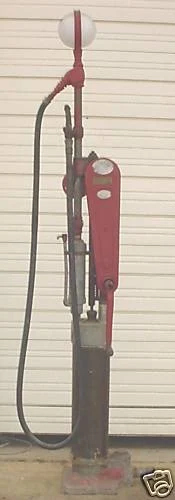 THE DICOVERER OF PETROL PUMPS SYLVANUS BOWSER
THE DICOVERER OF PETROL PUMPS SYLVANUS BOWSERPrior to the invention of the automobile, gasoline was primarily seen as a useless by product of the kerosene refining process. Gasoline had been used on a limited basis for burning in some stoves and lamps kerosene, also known as coal oil, was the primary ingredient needed to fuel the lighting fixtures of the day.

Around
1883, a young man by the name of Sylvanius F. Bowser came up with an
idea to draw water from a well using a wooden plunger. In 1885, he
applied this idea to a kerosene pump attached to a wooden barrel and
founded S.F. Bowser Pump Company. The unit was self contained and
included the storage barrel, the plunger, a hand lever, and an upright
faucet lever. This pumping unit was a huge success and soon became known
as a "Filling Station". By 1890, he had adapted this unit to pump
gasoline in addition to kerosene for the lighting industry and the first
true gas pump was born. S.F. Bowser continued to refine, improve, and
sell his new indoor "Filling Stations" to general stores and the first
automobile repair garages beginning in 1893.
Between the years 1893 and 1905, early motorists often filled
automobile fuel tanks using the "drum and measure" method. Gasoline,
stored in bulk steel drums, would be gravity fed into five-gallon
measuring cans
then poured directly through funnels into the automobile fuel
tank. The funnel was lined with a heavy rag or chamois in order to
strain sediment that might damage the engine or hurt performance. This
process was time consuming, inaccurate, and quite dangerous.
It
would not be until 1905 that Bowser would develop the first outdoor
"Filling Station" pump that could dispense kerosene or gasoline. The
Bowser Self-Measuring Gasoline Storage pump consisted of a square metal
tank enclosed in a secure wooden cabinet. The cabinet was equipped with
forced suction pump operated by hand stroke lever action

TRUCK STANDING IN FRONT OF OLD HAND CRANK PETROL PUMP.THE HANDLE TO PUMP(CRANK) THE PETROL INTO THE VEHICLE CAN BE SEEN AT THE BACK OF THE PUMPS[shell company gas station]




CLICK ON PHOTO TO ENLARGE IT
Kerosene and gasoline could be purchased at the local general
store from barrels that dispensed the product into one-gallon cans or a
container furnished by the customer. This method of kerosene and
gasoline storage and delivery soon proved to be messy and dangerous.

VINTAGE HAND CRANKED PETROL PUMP IN FRONT OF COTTAGE[Texaco company's gas station]

the origin of the first gasoline pump as it relates to the kerosene illuminating industry, and the invention of the automobile prior to 1900. While the internal combustion engine was invented in 1875, the first true gasoline powered "horseless carriage" was produced in 1890 by PanHard-Levassor, a French carriage company. The first American gasoline-powered motor vehicle was introduced by Frank and Charles Duryea in 1893. Henry Ford's first model A would not appear until 1903.
1880 CAR(HORSELESS CARRIAGE)
1880 CAR HORSELESS CARRIAGE

AN OLD (VINTAGE) PETROL PUMP ;OPERATED BY HAND POWER(HAND
CRANKING).SUCH OLD TYPE PETROL PUMPS WERE SEEN IN TRIVANDRUM CITY IN
1950
[ TEXACO(ESSO)
AND BURMAH SHELL OIL COMPANIES OF US AND UK WERE NATIONALISED BY INDRA GANDHI IN THE 1970
AND BURMAH SHELL OIL COMPANIES OF US AND UK WERE NATIONALISED BY INDRA GANDHI IN THE 1970
AFTER NATIONALISATION TEX(ESSO) WAS NAMED HP(HINDUSTAN PETROLEUM)AND SHELL
WAS NAMED BP(BHARAT PETROLEUM]
WAS NAMED BP(BHARAT PETROLEUM]
 HAND OPERATED (CRANKED) PETROL PUMP
HAND OPERATED (CRANKED) PETROL PUMP.
It would not be until 1905 that Bowser would develop the first outdoor "Filling Station" pump that could dispense kerosene or gasoline. The Bowser Self-Measuring Gasoline Storage pump consisted of a square metal tank enclosed in a secure wooden cabinet. The cabinet was equipped with forced suction pump operated by hand stroke lever action. This pump was also equipped with pre-determined quantity stops, air vents, and a hose attachment that allowed gasoline to be dispensed directly into the automobile fuel tank





BJ-yJBDfs!~~_12.jpg)



